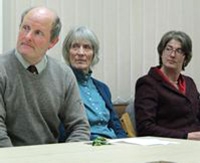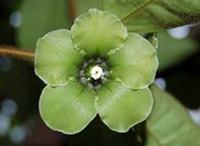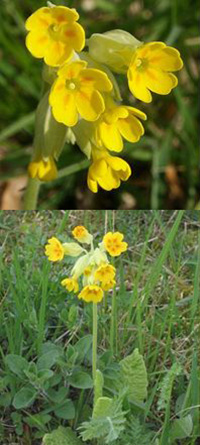This month sees three important events. It starts with the Agri-Food hub meeting, Waste Not Want Not: Agri-Food Waste Solutions for a Hungry World on 5 March. This is followed by our visit to Eccleston Square gardens and the Royal College of Physicians medicinal garden, Ceanothus and Medicinal Plants on 15 March. Finally we will be joining the Professional Horticulture Group South West for a three-day visit to Devon and Cornwall looking at horticultural polythene, cut flower production and two more traditional gardens.
Editor
Advances in South-West Horticulture

Liz Copaz - the Cider Industry in the South West
Liz is a major consultant to the expanding small volume Cider Industry in the South West. She worked originally in the Cider Department of Long Ashton Research Station and then branched out as an independent consultant when Long Ashton was closed.
She described how cider production has risen from 200 million litres in 1976 to 900million today and with it the demand for cider apples. The industry has met this challenge by modernisation. Traditional orchards had only 40 trees per acre grown to a traditional tree shape and produced between 2-20 tons of fruit per acre. A modern orchard has between 250-300 trees per acre and produces 15-20 tons per acre but needs higher input to achieve this sustained yield year after year. The trees are now grown in close rows with a single leader. (see Newsletter Nov 2012). Summer pruning is done mechanically as is the harvest. At present fruit are shaken to the floor and then collected but a harvester is now being developed that will combine these operations and collect the fruit as it is shaken from the tree.
Cider varieties are usually bittersweet types with a high tannin content (greater than 0.2%). A main objective of breeding is to bring forward the harvest time by selecting lines derived from crosses with early dessert apples like James Grieve and Worcester Pearmain with a number of new varieties now being introduced.
The latest development in growing technique involves growing around 1450 trees per acre in 2m high 'hedges' with the trees tied to a wire instead of being individually staked. Using this technique a yield of 50 tons per acre can be achieved and the trees start cropping earlier in their lives. The new one-operation harvester is designed to harvest this type of crop.
Sarah Chester - Education in the RHS
Her initial career was as a Bond Street fabric specialist but, like many, chose to escape the London rat-race. After retraining at Kew, Sarah was appointed in 2000 to bring all the RHS education programmes under one roof starting at Rosemoor in Devon. Initially lacking any facilities she then had a log cabin built on the outskirts of the Rosemoor site to keep the children away from the adult visitors. She now has a modern inspiring building and the children are allowed to mix with the adults!
Education is very much based on activities at the centre so distance is the most significant factor influencing the schools she can attract. Most of the schools that come to the centre are no more than 1.5 hours coach drive from Rosemoor. She takes everything from pre-school children and primary to key stage 1-2. The number of secondary schools is growing but they find it difficult to timetable in such visits.
She has developed a number of teaching modules to entertain and educate children based on flower colours, soils (children are allowed to get their hands dirty!), sowing seeds, etc. To keep the interest going through the winter she involves them in rush and bamboo weaving and dyeing with natural dyes like onion, madder and wood. These techniques are now being spread to other RHS gardens.
Bill Herring - Cauliflower and other Brassica trialling in Cornwall
Brassicas, in particular the cauliflower crop, are vital parts of the Cornish rural economy. Finding suitable cultivars capable of cropping satisfactorily is essential and Bill Herring, now Head of Horticulture at Duchy College, has for many years taken a special interest in fulfilling this task. His work is funded now by the Horticultural Development Company (HDC) producing annual recommendations of new hybrid cultivars for growers' use.
Winter cauliflower is grown mainly in Cornwall on fields where two or three air frosts would be considered a hard winter. Since 1980 the number of growers has fallen from 300 to 32 and the area from 3000ha - 2200ha but the total production has remained steady as the fewer larger growers improve their yields. These growers are able to supply most of the UK demand.
One of the biggest factors in this yield increase has been through improved varieties. Up to the mid 1990s varieties were highly variable (open-pollinated outbreeders) and with a resulting harvest period of anything up to two months. Continuity of production could be achieved with around 15 varieties. Few breeders were therefore interested in the crop. However, the introduction of much more uniform F1 hybrid varieties has galvanised breeders interest and shortened the harvest period to about 1 week. To maintain continuity they now grow 35-40 varieties. Bill now tests around 96 varieties as well as carrying out experiments on spacing.
In 1967, variation in the open pollinated varieties meant that only around 55% of the crop was marketable. Modern FI hybrids have virtually eliminated waste.
Peter Grimbly
Plant of the Month
Deherainia smaragdina, emerald death flower, Primulaceae

The startling green flowers (smaragdina means emerald green) look almost unreal. They have anthers that sit very close to the central stigma as the flower opens but then the anthers later spring away revealing the stigma.
The revolting smell that the flowers emit is a characteristic of sapromyophily - or pollination by flies that normally visit dead animals or dung! Charming….
A study of floral odours of plants in the Theophrastaceae reveals that the horrid smell is due to 3-methylbutanoic acid - a minor component of the essential oil but the one that has the overriding impact on the smell nonetheless. This acid (also known as isovaleric acid) is reported to have a 'strong pungent or cheesy smell' and is indeed the major component of the cause of unpleasant foot odour when it is produced by skin bacteria metabolising leucine!
3-methylbutanoic acid or isovaleric acid
Alison Foster
Oxford Botanic Garden
Medicinal Plant of the Month
Primula veris, cowslip, Primulaceae

This cheery little plant used mainly to be found growing in open pastures in rural settings, but can now often be seen in abundance on the landscaping at the side of motorways as it is frequently added to wild-flower mixes used in these types of situations. It is native to much of temperate Europe and Asia, but is absent from some parts of northwest Scotland.
It is part of a genus containing over 400 species, where almost all exhibit a phenomenon called heterostyly. This is when plants will either bear flowers with short styles and anthers at the mouth of the flower (thrum) or long styles and anthers down inside the flowers (pin). This duality promotes outcrossing, with pollinators (mainly bees) receiving pollen from one type in a position appropriate to depositing it on stigmas in the flowers of the other type.
The most popular common name, cowslip, may come from the old English for cow dung, as it was often found growing in cow pastures. Another common name is palsywort - the wort ending suggesting a former medicinal use. Today however it is a major constituent of a German herbal medicinal product which also contains extract of yellow gentian, black elder, common sorrel and vervain. Sinupret is indicated to improve the symptoms of acute inflammation of the paranasal sinuses. Testing has shown that it does indeed show a broad anti-inflammatory impact as well as exhibiting anti-microbial activity. Primula veris is known to contain chemicals called saponins, which may be responsible for this beneficial biological activity.
Alison Foster
Oxford Botanic Garden
News from our Associates

The Society has published its response to the Open Access Publishing inquiry from the House of Lords Science and Technology Select Committee.
Its response can be viewed here.

The Federation is preparing for its Annual Meeting to be held in Dundee on 16-17 April.
Horticulture Industry News
For the very latest horticultural news follow us on Facebook and or
Twitter.
Mystery cotton disease
The main cotton growing area in Tanzania has recently been affected by what appears to be a new disease, afflicting most of the crop in that area. Temporarily named 'Premature Defoliation Syndrome' (PDS), the disease causes leaf distortion, where the leaves become red in colour and are prematurely shed. PDS can cause 100% loss of marketable yield. Dr Rory Hillocks of NRI is working with the Tanzania Gatsby Trust as a consultant to support efforts to understand this new problem. Cotton is one of Tanzania's most important exports and reputedly 14 million people, 40% of the workforce, derive at least part of their income from cotton growing, marketing and processing.
Plastics from pine sap
Scientists at the University of South Carolina are developing new plastics based on polymers that often come from pine trees, firs and other conifers. The rosin and turpentine derived from their wood is rich in hydrocarbons similar, but not identical to, some components of petroleum. With petroleum derivatives, scientists have invested more than a hundred years of research into refining the polymer chemistry involved, but processes for developing plastics from renewable sources, such as rosin and turpentine, are not nearly as developed. The laboratory is a leader in helping change that situation. The aim is to understand how the macromolecular compositions and architectures dictate the properties of the materials. More
How the daffodil got its trumpet
The daffodil is one of the few plants with a 'corona', a crown-like structure also referred to as the 'trumpet'. With its colourful petal-like appearance, it's easy to see why this was believed for so long to be derived from a petal. By studying the development of daffodil flowers, the researchers found that the corona only begins to form after the other parts of the flower are fully established. This shows that the corona could not be a straightforward modification of either petals or stamens since it develops independently of both. It is more accurately described as a separate organ. The researchers analysed genetic activity in all parts of the daffodil flower, and found that daffodil coronas were genetically similar to the stamens and hypanthium, but not the petals.
Transpiration is perfectly in tune
Plants contain a continuous water column from the roots, where water is absorbed, to the leaves, where water is lost through evaporation via the stomata. When a plant's cells require water, opening stomata makes water potential in the xylem strongly negative and water is pulled from the soil into the roots and into the xylem strongly and quickly. However, the water potential gradient can be too steep, causing cavitation (bubbles) in the xylem, which slows down water transport. The optimum transpiration rate occurs when water potential and cavitation are balanced in the right way. According to new research plants are able to maintain a transpiration rate very close to the maximum theoretical transpiration potential, allowing partial cavitation but not letting it limit hydraulic conductivity. More
Wildflowers help spiders
UK researchers have found that by planting wildflower seeds and using a herbicide that reduces grass growth, they can enhance the number of wildflowers growing in existing strips of grass at the edges of farmers' fields. This increases the number of spiders living in these grass strips, which then feed on crop pests like aphids. Spiders play an important role in UK ecosystems, both as predators of small insects and as prey for larger animals. But like other invertebrates such as bees and butterflies, their numbers are declining because of modern farming practices.
Electrons clean seeds
Scientists in Dresden, Germany have developed an environmentally friendly method for removing disease spores from seeds. They treat the seeds with electrons, which within milliseconds destroy the DNA of any harmful organisms on the seed surface. The treatment uses low-energy accelerated electrons and is effective against bacterial and fungal pathogens. High energy electrons or Beta particles are easily stopped by solid objects so the low energy particles only act on the surface and in the seed coat. The embryo in the interior of the seed is not affected so that the ability of the seeds to germinate is not impaired. More
Sugar influences the onset of flowering
It has long been thought that plants must also ensure that they have sufficient resources for the energy intensive process of building flowers. As scientists in Germany now report, the sugar molecule trehalose-6-phosphate (T6P) takes on a key role in monitoring energy reserves in thale cress, Arabidopsis thaliana, thereby controlling flowering time in relation to energy reserves. Since plants contain only minute amounts of T6P, it has been suspected that it could be a signalling molecule. By blocking the production of T6P, flowering was delayed and in extreme cases stopped altogether. This held true even when the plants were grown under highly inductive conditions. They have shown that this T6P is indispensable for the production in the leaves of the FT protein which promotes flowering. More
Events Calendar
Poland - Chance or Challenge
2 - 9 Mar, Under 40s Fruit Growers Tour
Poland
British Plant Fair
7 Mar, The British Plant Fair
Stoneleigh, UK
Slow- and Controlled-Release and Stabilized Fertilizers
12 - 13 Mar, New AG International
Rio de Janeiro, Brazil
Green Health Conference
11 Mar, James Hutton Institute
Dundee, UK
New AG International
13 - 15 Mar, New AG International
Rio de Janeiro, Brazil
Highbush Blueberry Conference
15 Mar, Hortus Media and Zagodnik
Borowkowa, Poland
Rhizosphere Interactions
18 Mar, James Hutton Institute
Dundee, UK
Evolution of the Plant Soil Interface
19 Mar, James Hutton Institute
Dundee, UK
Pesticide Use and Risk Reduction for Future IPM in Europe
19 - 22 Mar, Fondazione Edmund Mack, Pure, Laimburg
Riva del Garda, Italy
From Farm to Fork - Plant Molecular Breeding and Post-harvest Research in the 21st Century
23 Mar 2012, PlantLink, Food Technology at Lund University and Department of Plant Breeding
Lund, Sweden
Crop Resource Use Efficiency and Field Phenotyping
25 - 26 Mar, Association of Applied Biologists
Grantham, UK
Middle East Horticultural Summit
26 Mar, International Society for Horticultural Science
Dubai
Temperate Zone Fruits in the Tropics and Subtropics
26 - 28 Mar. International Society for Horticultural Science
Chiang Mai, Thailand
Flowers & Hortech, Ukraine
9 - 11 Apr, BTO Exhibitions
Kiev, Ukraine
UK PlantSci
16 - 17 Apr, UK Plant Science Federation
Dundee, UK
IFST Spring conference 2013: Securing the Future Supply of Food
17 Apr, Institute of Food Science and Technology
Norwich, UK
Grapevine Physiology and Biotechnology
21 - 26 Apr, International Society for Horticultural Science
Santiago, Chile
Intervitis Interfructa
24 - 28 Apr , Messe Stuttgart
Stuttgart, Germany
Discovery and Development of Innovative Strategies for Post-harvest Disease Management
29 Apr - 2 May, International Society for Horticultural Science
Kusadasi, Turkey
Integrated Control in Citrus Fruit Crops
7 - 9 May, International Organization for Biological and Integrated
Control of Noxious Animals and Plants
Adana, Turkey
Building a Better Future: Responsible Innovation and Environmental Protection
12 - 16 May, Society of Environmental Toxicology and Chemistry
Glasgow, UK
Plant Genomics Congress
13 - 14 May, Global Engage
London, UK
Hydro Eco
13 - 16 May, University of Rennes
Rennes, France
A Diet for Sustainability - Eat, Drink, Be Ready
16 May, Association of Applied Biologists
Harpenden, UK
An Introduction to Opportunities in Plant Synthetic Biology
21 - 22 May, Warwick University
Nottingham, UK
Symposium on Almonds and Pistachios
27 - 31 May, International Society for Horticultural Science
Murcia, Spain
If you would like to advertise a forthcoming event please contact. karen.hobbs@soci.org
Horticulture Group Contact Details
For submitting ideas or to volunteer to be part of a committee or a group, please contact:
Chairman - Peter Grimbly
Meetings Secretary - Alison Foster
Minutes Secretary - Margaret Waddy
Newsletter co-ordinator - Sue Grimbly scihortigroup@btinternet.com
Group Contact - Karen Hobbs, E: karen.hobbs@soci.org T: +44(0)20 7598 1586
